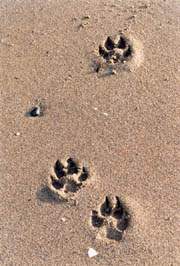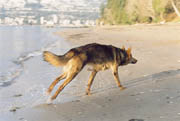
I have had the fortunate experience of having on several occasions encountered the Brush Wolf, or Canis latrans.
I first learned of the Brush Wolf as a young lad, 11 or 12 or so. In 1976, my parents moved us from Ottawa to a rural property about 30 miles west of the city. We were the first family to move in along this stretch of concession 3, Beckwith Township, 3/4 of a mile of cowtrack, grass growing up the middle, from the nearest dirt road.
On this 68-acre parcel of land, wildlife was plentiful where my parents built our bungalo beside the old beaver swamp. Although uncommon, there were sightings of snowy owls, black bears, wolverines, golden eagles and even timber wolves.
One morning that first winter, we woke up to bobcat tracks practically crossing the front lawn. The chickadees would eat bird seed from my father's hand.
One afternoon sometime in the dead of winter, a couple of snowmobiles pulled into the front yard. My father stood and talked to them in the yard, two men with rifles. With the help of their dogs, they had been able to corner a brush wolf on the back of our property. There were no hunting signs posted, so they had come to ask permission to enter the property in pursuit of this brush wolf, which they claimed, had been killing sheep. My father complied.
An hour or so later, the men on skidoos returned with their dogs, dragging behind them the body of the fearsome brush wolf. It was a sad looking sight — a scrawny little thing, thin, not a large or formidable creature at all. My heart was heavy with pity. So much so that, not long after I entered a debate in the local town paper regarding the hunting of wolves in Lanark County. I wrote an anonymous letter to the Editor of the Carleton Place Canadian.
The letter appeared in the next weekly edition of the paper, with an editor's note stating that although it was the paper's policy to not public anonymous letters, this letter had obviously come from a young person so they ran it.
In the letter I listed many of the habits of Canis lupus, that I had gleaned from Farley Mowat's Never Cry Wolf, where he documented the social habits of a pack of wolves he had lived and ate mice with in the far North.
Hunting, bounties, traps and poison, and all the controversy such topics can stir it seems could not eliminate the brush wolf, also known as "coyote." The coyote flourishes, true to the bumper sticker slogan: "Eat Canadian lamb, 10,000 coyotes can't be wrong!"

As I was turning 30, I fled Toronto and landed in a little 1920s apartment building, nestled next to Lost Lagoon and Stanley Park, Vancouver. Anxious to escape the vortex created by the hustle of a big city, I took refuge in the steamy drizzle that engulfed Stanley Woods, like the mists cling to Avalon. Day after day I took leisure among the old-growth red cedars, and one day I came face to face with the Stanley Woods Brush Wolf. It was rumoured that coyotes had moved into Stanley Park, but I was startled all the same. It was not phased however, staring at me from a distance of not ten yards, then with indifference, it turned its back and sauntered away. I was immediately enamoured and intrigued.
Coyote sightings became increasingly common in Vancouver, the West End, Kitsilano and Burnaby. One winter night, a companion and I were running around the seawall that surrounds Stanley Park, with a friend's dog she had borrowed for the exercise. Shortly after we passed Second Beach, we noticed we had picked up company. A coyote had been following us about 30 paces behind, sometimes in the trees along the roadway, sometimes along the beach, below the seawall. To be honest we were anxious for Niko's safety. While he was a confident and well-muscled dog, he wasn't large. The coyote followed us without incident along our whole run along the sea wall and up past the zoo, exiting at Lost Lagoon.
Sightings of coyotes and now news reports continued to increase in Greater Vancouver. Over the course of the next few years I personally saw a coyote on several other occasions, around the Aquatic Centre, in Nelson Park, along the beach and in alleys behind restaurants in the West End.
One unusual day in December, 1999 I found myself at the Vancouver City Pound, after a long stroll Strathcona and the community gardens. How could it hurt to look around, right? The Vancouver Pound was very progressive, they were one of the first to enact a "no-kill" policy, and received large donations of food from Science Diet® because of it. As I strolled up and down the chainlink gates it was immediately obvious. I knelt down to greet "Mollie" and she nervously backed into the gate, pushing her head against the mesh for me to scratch behind her ears. The deafening roar of dog barks and shrieks hushed.

"I hate this kind of dog," the handler announced and she let Mollie loose in the compound. A muddy mucky day, Molly jumped up all over the woman before making for the bushes and slinking off to pee. You could tell she liked Molly has she pretended to be annoyed, and said, "There's something wild in that dog." She was letting me know that this dog was energetic, untrusting and hard to handle. But it didn't seem to matter. My heart was set. Molly had been roaming Trout Lake, wild without a collar. She was brought in by someone who had managed to catch her. No one knew any more than that. Judging from her teeth she was about seven months old.
It was usual to receive one to three comments on any walk down the street with Molly, enquiring into Molly's ancestry. While I insisted that Molly was a German Shepherd/Collie cross, the person who was most convinced otherwise chatted with us about it every time we ran into each other in the Nelson dog park. She knew Molly wasn't a coyote or a wolf or a fox. She knew exactly what a coyote looked like because an several occasions a coyote had played for hours with her white Samoyd Husky late at night in this very park. "Molly is half coyote and half Shepherd. It's obvious."
Very late one night in March, Molly and I head out for the Aquatic Centre and not long after we get there Molly is off like a shot in the dark. I can bearly see her racing in the shadow of the hill, and I notice there are two of her?! We had encountered the Stanley Woods Brush Wolf. Then I noticed that they were chasing each other — playing, racing round and round the beach and park. I decided to continue along the deserted path on the way to Second Beach.
I whistled and called for Molly regularly, and dutifully she would catch up to my heels. The coyote would follow not too far behind, then they would tear off along the beach again. I stopped and went down to the beach at Second Beach and sat down with my back against a huge drift log. I sat and watched for what seemed like hours as the two of them played in the surf. Molly would run into the sea, but the coyote would not follow, instead baiting her to come ashore and play some more.
Eventually Molly got tired and came to check in on what I was up to, and the coyote tagged along.I sat very still as the coyote tip-toed along the top of the log, against which I was resting. He was smaller than I had thought, really maybe just a bit more than half Molly's height. He was fat like a little furry sausage, and very woolly looking. And that pointy little face. He was quite inquisitive.

The moment was so magical I didn't want to bring about it's end. Eventually though dawn was on the way, so I got up and headed for home. Back along the path, past English Bay, past the Aquatic Centre I walked with Molly and the coyote followed. We passed under the Burard Bridge past the marina where the False Creek condos are. Along the way we passed a security guard, who yelled out, "hey, that dog looks like a…" Before he could utter the next word the coyote passed him, leaving him stammering as I called, "Come on, guys!" We continued along our way to beneath the Granville Bridge, where the coyote left us as we climbed our way back into the city and up the alley staircase into our flat.
![[Previous]](../previous_off.gif)
![[Enlarge]](../enlarge_off.gif)
![[Next]](../next_off.gif)